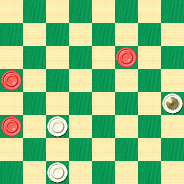Blind Man's Bluff

Most of us take our sight for granted, and we often forget that there are those among us who don't have this gift. Now, note that we don't call them "unfortunates"; we'd rather call them "inspirations" because the blind among us are capable of incredible things, often with a drive and willpower that puts the rest of us to shame.
An old time checker-player, one Mr. W. Bennett, was blind, but that didn't slow him down in the least, as the instructive problem below illustrates well.
BLACK

WHITE
White to Play and Win
W:WK20,22,30:B11,13,21.
Can you solve it? For an extra challenge, try to work it out the way Mr. Bennett did; solve the problem not only without moving the pieces, but without looking at the diagram or a checkerboard. Along the way, you'll discover a subtle and practical winning technique which you'll be able to put to use in your own play.
When you've completed this truly illuminating exercise, click on Read More for the solution, a sample game, and notes.![]()
Solution
Editor's Note: To further develop your understanding of the blind, try going through this solution with an audio screen reader rather than looking at the text. The problem and solution material is taken from Ben Boland's Famous Positions in the Game of Checkers, and forms part of our ongoing Checker School series.
20-24, 11-15, 24-27, 15-19, 27-31, 19-24, 22-18, 24-28 (if 13-17, 30-26), 18-14, 28-32, 14-9, 32-28, 9-6, (31-26, 13-17, 9-5, etc. White Wins), 28-24, 6-2, 24-19, 2-6 (31-26 wins too), 13-17, 30-26 (or 31-26), 19-15, 6-9, 15-18, 26-23, 18-27, 31-24, 17-22, 24-27, 22-26, 9-14, 26-30, 27-23, 21-25, 14-17. White Wins.
Game: 11-15, 23-19, 9-14, 27-23, 8-11, 22-18, 15-22, 25-9, 5-14, 29-25, 11-15, 24-20, 15-24, 28-19, 7-11, 19-16, 12-19, 23-7, 2-11, 25-22, 6-9, 26-23, 4-8, 31-27, 8-12, 27-24, 11-15, 21-17, 14-21, 23-18, 15-19, 24-6, 1-10, 32-27, 3-7, 27-23, 7-11, 23-19, 10-14---A, 19-15, 14-23, 15-8, 23-27, 8-3, 27-32, 3-7, 32-27, 7-10, 27-23, 10-6, 9-13, 6-10, 23-19, 10-14, 19-15, 14-18, 15-19, 20-16, 19-23---B, 18-27, 12-19. Forms above position, after 4th move. T. McLaren.
A---9-13 would form the Drummond-Dunne Position.
B---In Game No. 3060 in the Newcastle Weekly Chronicle, and then as Game No. 2007, the Draughts Review, April 1934, Vol. 10, H. Jackson vs. T. McLaren, continued; 19-15, 18-11, 12-19, 11-15, 19-24, 15-19, 24-27. Drawn.
The above position by W. Bennett, may be found as No. 163 in Lyman's and No. 780 in Gould's Problem Book. It may also be found as No. 150 Duffy's Standard Positions, Part 2, and No. 4, Page 50, "Familiar Themes."
A note in Lyman's Problem Book says, Mr. Bennett was blind.
You can email the Webmaster with comments on this article.